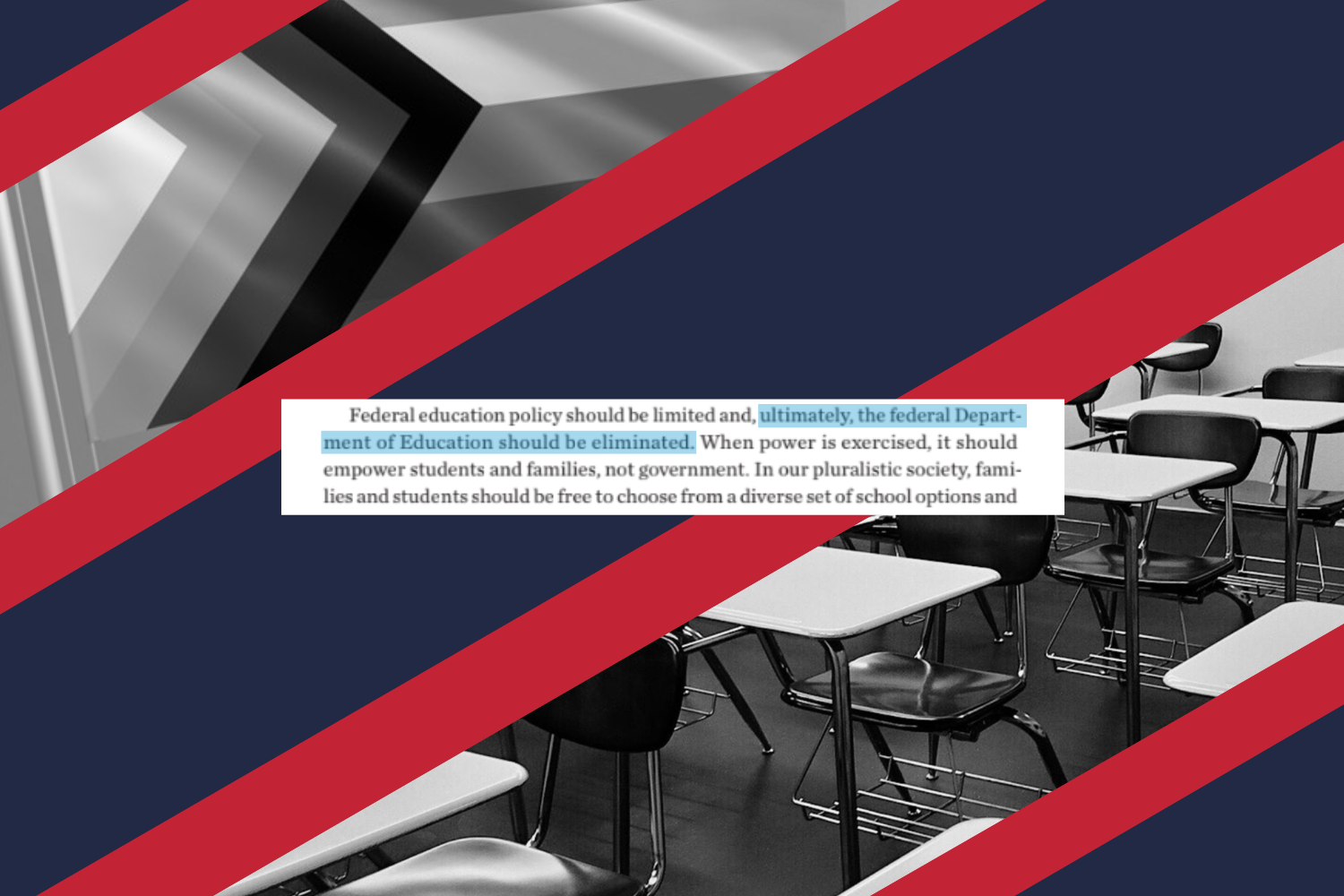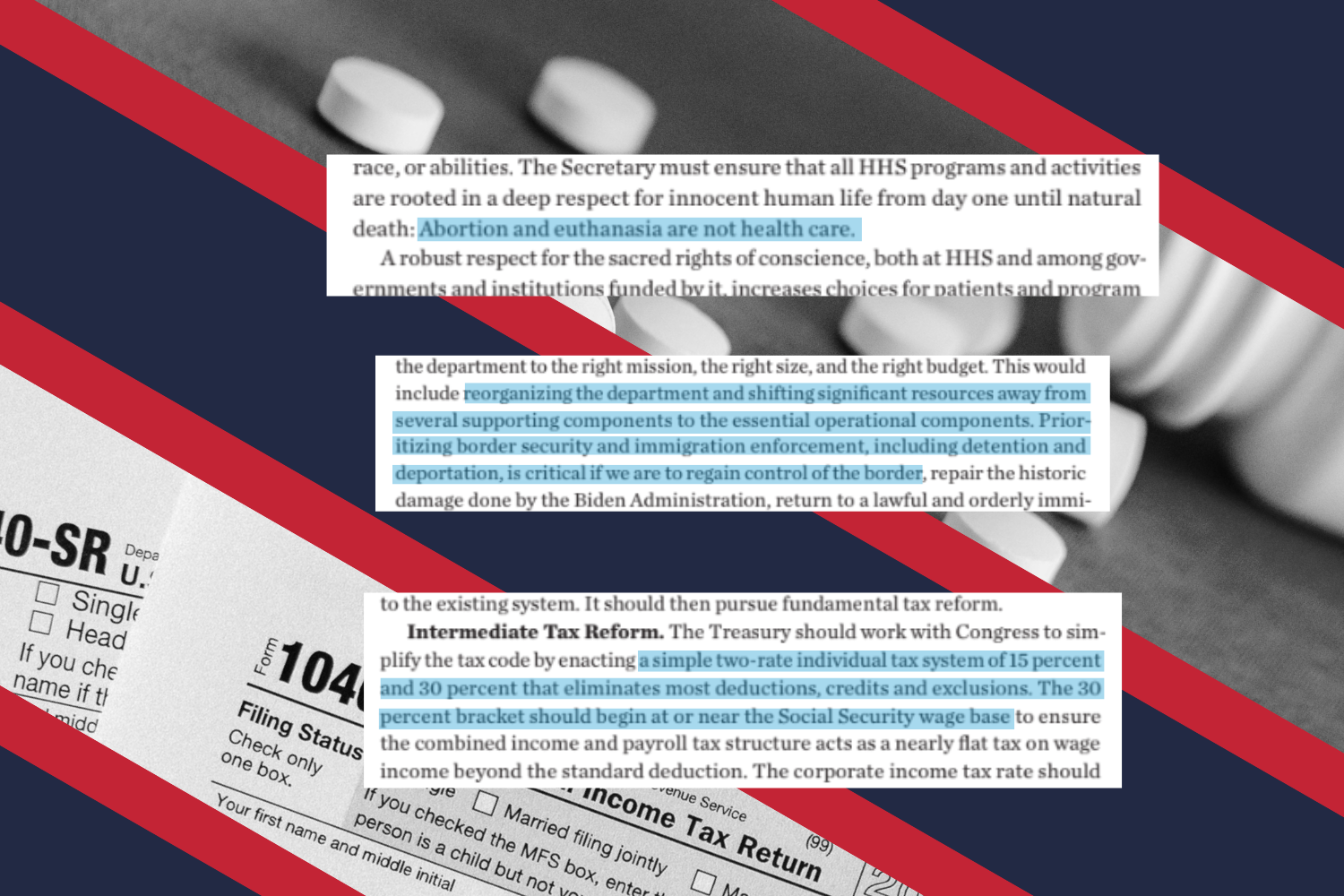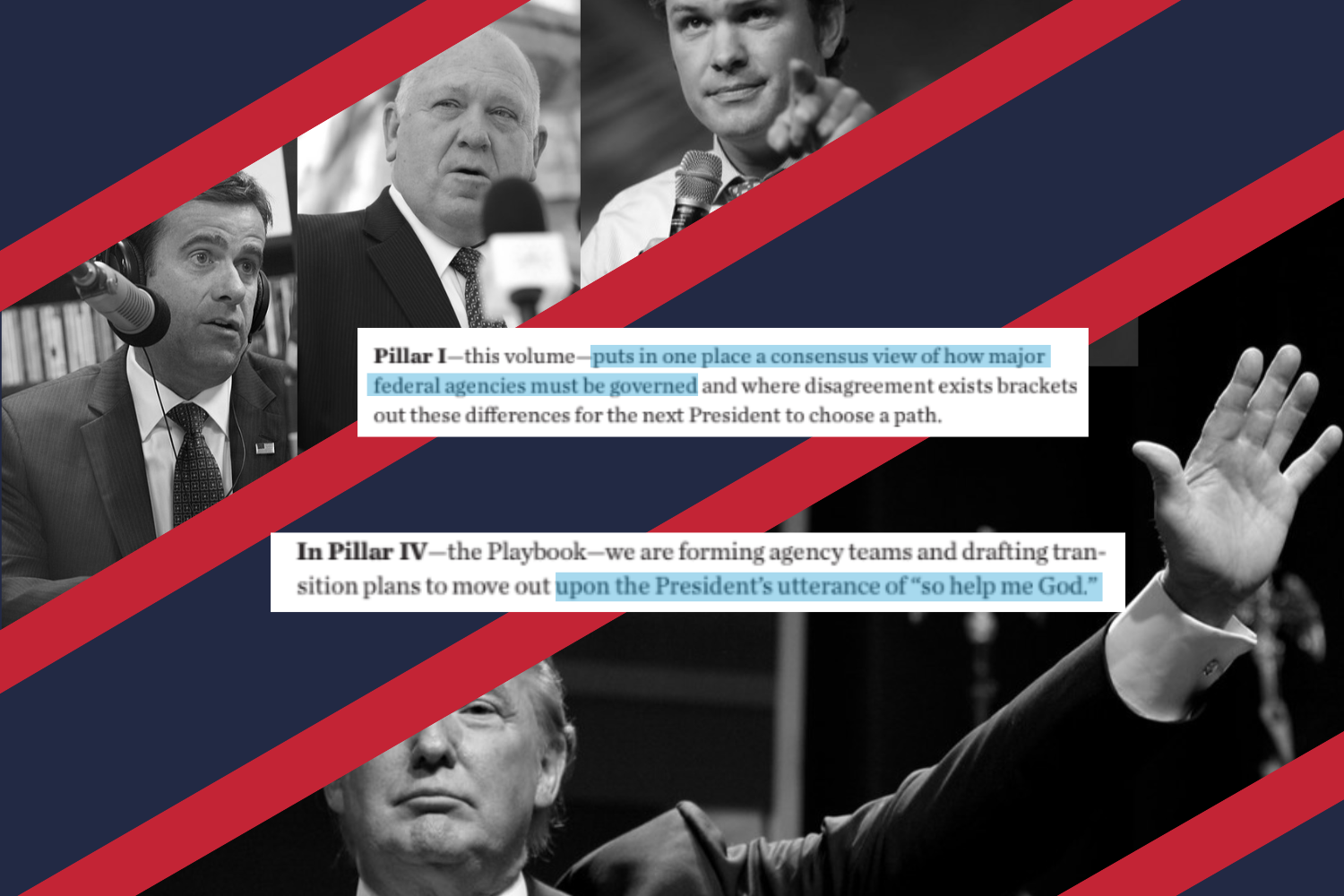Project 2025’s potential impact on America’s future


Project 2025 has a clear view of American education: an inefficient, “bloated” federal government has taken rights from individual states and families while dumping money into failed equity-driven programs. The plan wants to eliminate the federal Department of Education in an effort to redirect power back to states.
This would include cutting federal programs like Head Start and the Community Eligibility Provision, found on page 482 of the document. Head Start provides free group learning to low-income children ages 3 to 5 years old. CEP requires schools with 25% of their students below an income threshold to offer free meals, serving 15.5 million students across the country. Project 2025 would replace CEP with a program that gives meals directly to low-income students, not entire schools: something the government currently avoids because of the stigma students can feel for being the odd one out. In California and eight other states, free meals are universal regardless of income and would be protected from a national repeal of CEP.
Critics of Project 2025 say ending long-standing federal programs could reverse years of progress. Head Start is a key source of daycare for many rural families across the country. The program provides education to over 800,000 children each year. Title I, another program Project 2025 plans to phase out, provides funding for low-income school districts. Eliminating it could affect 2.8 million of the nation’s poorest students and lead to the loss of 180,000 teaching positions nationwide and 16,000 positions in California, according to the Center for American Progress, a liberal research and advocacy organization.
The list continues with a section titled “Department of Education” by Linsey Burke, the director of the Center for Education Policy at the Heritage Foundation. Burke seeks to end President Joe Biden’s plan to forgive student loans and reduce funding for the Individuals with Disabilities Act. The Department of Education, which was created in 1979 by former President Jimmy Carter, collects national data on school finances, demographics, mental health and more. Rep. Rosa DeLauro claimed that eliminating the Department of Education would be “a direct attack on teachers and public education.”
“Not all schools are like Lynbrook,” social studies teacher Mike Williams said. “But even though we have funding, unbalancing the federal government will always trickle down to California. We could see a limit in access to funding for public education.”
For Project 2025, reducing federal funding for public schools is part of a greater plan to steer families away from them. Right-wing politicians feel public education has been infiltrated by “woke,” “left-wing” beliefs, such as ethnic studies and LGBTQ+ identity. Republican Sen. Ted Cruz from Texas said in a 2022 Fox News interview that parents should “stand up against the radical left that is trying to indoctrinate our kids in schools.”
Project 2025 emphasizes the importance of school choice and the alternatives to public school, available to each family through voucher systems that give scholarships to private school students. The plan goes further by directing a portion of public school funds into private Education Savings Accounts allocated to families of students under the age of 18. Families can use ESA funds to pay for textbooks, online courses or tuition. However, these funds would come from taxpayer money, and paying public funds to private or religious institutions could violate the First Amendment, which separates Church and State.
“You are using public money to fund another person’s choice that may not align with the overall intent of the public,” Williams said. “There’s already an inequality in the public school system that exists now.”
Either way, Burke plans to fight “wokeness” in schools with a detailed plan on page 333 to strip public education curriculums of a “left-wing social engineering agenda.” Project 2025 would erase terms like “nonbinary” and “transgender” from curriculums and redefine “gender” to mean “biological sex assigned at birth.”
Burke furthers efforts to control curriculum content in a Parent’s Bill of Rights on page 344, which would allow parents to have a greater say in school curricula. Curricula are drafted and taught by experts, and critics say opening them up to parental involvement could increase unnecessary censorship and undermine an unbiased curriculum. In Florida, Gov. Ron DeSantis signed a bill that allowed schools to ban books based on parental input which subsequently faced lawsuits over bans of works by Maya Angelou and Ernest Hemingway. Book bans have already risen 65% from 2022 to 2023 and disproportionately affect books with LGBTQ+ characters or themes.
“Parents play a pivotal role in their children’s education,” said political science professor and instructor at De Anza College Ishmael Tarikh. “They should have a seat at the table and have a voice that’s taken seriously about the input that they have for policy. But just because someone’s a parent it doesn’t mean they’re well informed. They should be active as parents but not attacking teachers about how their children aren’t being properly educated.”
Of the widespread criticism of Project 2025, its stance on LGBTQ+ topics has garnered the most controversy. The Williams Institute at UCLA’s School of Law says the conservative manifesto would deny the identity of 3.2 million students in the LGBTQ+ community. Clauses containing non-biological gender or sexuality in Title IX, a law preventing sexual discrimination in schools, would be removed, withdrawing protections for gender-based discrimination. Since 2011, schools have had an accepting stance on LGBTQ+ students, and gender-affirming care has been shown to reduce the risk of suicide in transgender students. The American Civil Liberties Union, a nonprofit civil rights organization, called Project 2025 “a sweeping anti-LGBTQ policy agenda.”
Aside from the ACLU, conservatives have also clashed with the National Education Association, America’s largest teacher union, for its left-wing views. In FUHSD, teachers are part of the Fremont Education Association and affiliated with the NEA by proxy. Project 2025 includes a plan to defund the NEA for its “radical racial and gender ideology” on page 342. The NEA, which includes 3 million teachers, has also been vocal against Project 2025 due to concern over censorship, discrimination against LGBTQ+ students and reduced funding for public schools.
In California, Gov. Gavin Newsom’s $25 million plan to “Trump-proof” the state could stymie Project 2025. The plan includes increased protections for LGBTQ+ students. California state law would ensure Transitional Kindergarten for children 4-years-old and above. Sex education is currently protected through the California Healthy Youth Act and protection for LGBTQ+ rights is secured through state legislation.
“I strongly care about our schools being the safest place that the students can be and that all of our students are able to show up to school as who they truly are,” FUHSD Associate Superintendent Trudy Gross said.
While it has captured national attention, Project 2025 isn’t the first right-wing attempt to reform American education. In the 45 years since the Department of Education’s creation, many Republicans have lobbied for its removal. Like Burke, they believe education should be funded and managed by individual states. They argue that the department was effective in reducing civil rights inequalities in the past but is now unnecessary and unconstitutional.
“Education is a very politicized field,” Williams said. “It’s something that is often talked about in the media and in government circles because it affects families and kids. It’s code for ‘we want to shape how things are taught and what things are not taught.’”

Education is just the tip of the iceberg for Project 2025. The Heritage Foundation also proposes massive changes to healthcare, immigration and taxes. On page 457, Attorney Roger Severino, an author of Project 2025, advocates for a ban on mail-order abortions, prohibiting taking the abortion pill after 49 days of gestation as well as increased surveillance and reporting on women’s abortions. Abortion pills accounted for 63% of U.S. abortions in 2023, according to the Guttmacher Institute, a research organization dedicated to reproductive rights. Project 2025’s restrictions are stepping stones toward what The Heritage Foundation hopes will be a national abortion ban. On page 450, Severino affirms that “life begins from conception” and “abortion is not healthcare.”
Medicare, another aspect of healthcare, would undergo the Medicare Advantage plan, privatizing the program and restricting the choice of the elderly to certain networks of physicians and hospitals. Project 2025 would also place a lifetime cap on the length of time Americans can be enrolled in Medicaid, which the New York Times estimates could kick 20% of current qualifiers out of the program.
Project 2025 also advocates for a ban on gender-affirming care, which includes puberty blockers for minors and gender transition surgery. According to the National Institute of Health, 25% to 35% of transgender men and 28% of transgender women have received gender confirming surgery. The Supreme Court is already echoing Project 2025’s conservative promises. As of Dec. 4, it is expected to uphold a Tennessee law that would deny transition care to transgender youth.
Trump and Project 2025 are in full agreement on mass deportations of illegal immigrants. Project 2025 further advocates for stronger Customs and Border Protection and stricter asylum laws. Wall construction at the border would become a priority. As of July 2023, there are 11.7 million undocumented immigrants in the United States, all of which are at risk of deportation. However, according to The Guardian, there is a possibility that the plan would not be viable due to the expenses involved.
“I think that the plan would affect students and immigrants, especially in California,” DeAnza College political scientist Ishmael Tarikh said. “When you cast a net that wide, you can catch a lot of people who should not be caught in that net.”
Currently, the United States uses a progressive tax system, separated into seven brackets, where the percent rate of income tax paid increases as income rises. Project 2025 would simplify this into just two brackets: 15% for those with lower income and 30% for those with higher income, raising taxes for people earning under $150,000 a year and lowering them for those earning more. Some are concerned that lower and middle-income families could feel a heavier tax burden, resulting in widening income inequality. According to the CAP, “it would raise taxes by $3,000 for the median family of four.”
“When taxes are cut for everybody, it is certainly a good thing, but if we are cutting taxes on everybody and allowing the same tax cuts to be enjoyed by those in the highest tax brackets, that’s not good for our government revenue,” Tarikh said. “That’s what happened when Trump was in office: taxes were cut across the board. A lot of people enjoyed the cut of the corporation tax, but those who really were able to benefit from it were at the top echelons of our economic strata, not everyday people.”

In July 2024, the Supreme Court ruled that a president could not be indicted for crimes related to his or her power after Trump was accused of conspiring to overturn the 2020 election. The controversial decision came after a string of questions over the limits of presidential power, which Project 2025 answers by calling for “aggressive use of the executive branch to return power… to the American people.”
Russ Vought, the author of this quote, is now Trump’s pick for the head of the Office of Management and budget Cabinet. Vought proposes expanding presidential control over the FBI and Department of Justice, which Project 2025 claims would restore and nourish “law and order.” This allows potential influence over criminal justice cases, as well as cases involving the president. It has also raised alarms after Trump made over 100 threats to prosecute his political opponents in court.
Many critics such as the ACLU are alarmed by the unchecked power the president can possess and the ability they would have to pass favored policies while “punish[ing] people it disagrees with and control[ing] what news the media can report.”
“Our Madisonian model of government, which is based upon a system of checks and balances with a separation of powers, could be in real peril,” Tarikh said. “It’s going to be the setup piece for a high level of concentration in the executive branch.”
After a sweeping November victory, Republicans now control the senate, house, supreme court and the white house by a wide margin. This solidifies a “monopoly on power” for Republicans. In the House, bills only need a simple majority — 218 out of 435 — to pass, with Republicans holding 220 House seats. In the Senate, Republicans will occupy 53 seats in 2025, compared to the Democrats’ 47. Major bills passed on to the Senate would need around 60 votes to pass, but Republican sway provides a clear path for conservative policies.
Project 2025 also provides the new president the power to extensively fire current civil servants and replace them with loyal politicians. This is similar to Trump’s Schedule F, which calls for the president’s power to “fire rogue bureaucrats.”
“The question is: do you want people with skills, expertise and credentials to perform their jobs or do you want people who love Donald Trump?” said Jacqueline Simon, policy director of the 750,000 member American Federation of Government Employees, in a 2024 interview. “If the main factor is to get a job, you won’t have the same food safety, workplace safety, consumer product safety, mine safety and clean air and water.”
To assist in transition, Project 2025 also utilizes three other pillars, consisting of the personnel plan: a conservative network with over 11,000 applicants who have applied via the Project 2025 website. The “Presidential Administrative Academy” embodies the third pillar, which provides online and in-person conservative value workshops for those who apply. The fourth pillar, a playbook road-mapping the transition, is what the president is expected to follow in their first 180 days in office. These pillars attempt to ensure government positions are taken by those loyal to the conservative movement and the next conservative president.
Some aspects of Project 2025, such as mass deportation, may not be instituted without lawsuits from the states, while others will earn widespread support from conservative audiences. Trump had tried to distance himself from the manifesto during his campaign, claiming that he has “nothing to do with Project 2025.” However, many of its authors are his former aides and Trump recently attended the book signing of Kevin Roberts, former president of the Heritage Foundation and major champion of Project 2025. Furthermore, Trump has named three authors of Project 2025 as part of his Cabinet — Vought, Stephen Miller and Brendan Carr. Carr, Trump’s chosen chairman of the Federal Communications Commision authored the Project 2025 chapter on the same department. Many contributors to Project 2025 — Tom Homan, John Ratcliffe and Peke Hoekstra — have also been appointed. Furthermore, Trump’s political aide Karoline Leavitt had appeared in a Project 2025 training video. Trump’s own plan, “Agenda 47,” can be found on his website. Similar to Project 2025, the plan includes policies such as an encouragement of alternative school options, a mass deportation of illegal immigrants and a negative attitude toward LGBTQ+ identity and rights.
Regardless of Trump’s connection to Project 2025, its no doubt right-wing policies combined with a conservative majority have already affected American politics even before touching the congressional floor.























